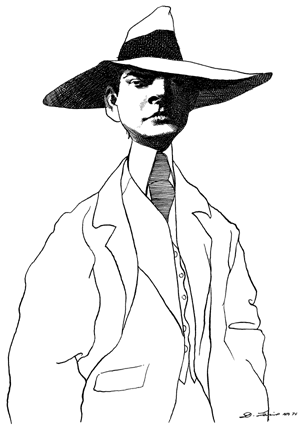Hecate is a goddess whose career has obscured whatever may have been the original intention of her imaginers. She can represent, in Greek mythology, the moon, the earth, and the underworld, and she is associated with Persephone and Demeter. She was believed to extend goodwill, in the forms of wealth and fecundity, to her propitiators, and statues of her, triple-headed, were erected at crossroads. But she was also supposed to have been the inventor of sorcery, the protectoress of Medea, and the mother of Circe. She is, in short, a convenient symbol of a dark-age notion of “the feminine”—a figure, in various guises, of mystery, beauty, and fertility, but, at heart, a succubus. She attracts, she seduces, she consumes.
Hecate’s reputation as a succubus is plainly what Edmund Wilson had in mind when he gave her name to the fictitious county where the stories in his second, and last, work of fiction take place. In case there was a doubt, he added an epigraph from a story by Gogol about a student who has been possessed by a beautiful girl who turns into a witch. And he made the central image of his book—the climax, so to speak, of the story—a description of a woman’s genitalia.
Memoirs of Hecate County was published in 1946.* It quickly outsold all of Wilson’s previous books, and then it went down in legal flames. Wilson later called it his favorite among his own books. Despite the sales, the book got a mixed reception from critics whose opinion might have mattered to Wilson, including Alfred Kazin and Cyril Connolly. It is not a book for every taste. For many readers who admired Wilson’s critical and historical writings, it probably seemed, by comparison with the clarity and firmness of that work, a little sordid, fantastical, and depressive. Several of the stories involve the supernatural, a feature that can put off modern readers, who may consider it authorial whimsy. But supernaturalism is natural to the short story. Many of the classical story writers—Poe, Hawthorne, James, Kipling—wrote ghostly tales. It’s true that the shape-shifting of “The Man Who Shot Snapping Turtles” and the time-shifting of “Ellen Terhune” and “Mr. and Mrs. Blackburn at Home” (in which the devil makes an appearance, and speaks in French) seem self-conscious. The ghostliness doesn’t always produce the little jerk of perception that signals a successful story.
But the supernatural stories serve the purpose of setting off the major story in the collection, the highly naturalistic “The Princess with the Golden Hair.” The female characters in “The Princess” are witchy, but they are not witches. Their feet remain on the ground. The story is nearly as long as the other five stories put together, and although it is of a time and a place long vanished, it continues to extend to us its weird intimacy.
The narrator of “The Princess with the Golden Hair” (as of the other five stories) is a Marxist art historian, of independent means, living in a suburb of New York City. Wilson lived in Stamford, Connecticut, between 1936 and 1938, when he was working on his history of Marxist thought, To the Finland Station, which appeared in 1940, and it is therefore presumably Stamford—a much more rural place then than it is today—that served as the original for Hecate County. Thanks to the diaries that Wilson later published, in which he recorded his amorous encounters in passages that no reader has ever thought insufficiently detailed, it is possible to identify real-life models for most of the characters in the story, including the two women with whom the narrator is chiefly involved, the resilient, working-class Anna and the sybaritic, suburban Imogen.
Still, “The Princess with the Golden Hair” was not lifted from life intact. The narrator, for example, is in a long-distance relationship with a woman named Jo Gates; in the final story in the volume, they marry. The model for Jo was almost certainly Margaret Canby, but Wilson married her in 1930, and she died, in an accident, in 1932. The woman Wilson married in 1938 was Mary McCarthy, who had the happiness (one of the few the marriage appears to have given her) not to be endowed with a fictional counterpart. The intimacy that “The Princess with the Golden Hair” gives us is not merely the intimacy of autobiography.
The vanished world of “The Princess” is the world of pre-war New York—of preppy advertising men and their spoiled, literary wives; of Ukrainian immigrants and bootleg gin joints; of Fourteenth Street dance halls and lunches at the Plaza; of countless highballs and earnest depravity. In Wilson’s imagination, this is a brutal world, and he fills it with brutal details, like the muskrat-eating contest between Ralph and the gangster, Fatty and his whores, Anna’s abusive car-thief husband with his imaginary brain tumor, the “charming” Rumanian doctor with his unspecified unpalatable sexual tastes, Imogen’s medieval back-brace. And then there is Imogen’s sex, the treasure box of the narrator’s long and dogged seduction—an organ so lubricious that it practically pleasures itself. The story is wrapped in a cloud of cynicism and disgust; it is the vision of a writer who believed that capitalism was the engine of terminal moral decay. But, as in everything that Wilson wrote, one feels, in every paragraph, the determination to tell the reader the way it really was:
Advertisement
I got to like the big-hipped cat-faced women of the photographs shown as lures out in front of the Fourteenth Street burlesque show; the announcements of moving picture palaces bejeweled with paste-bright lights; the little music shops that sold big brass-band instruments and Slavic and Balkan records and had radios that blared into the street; the Field’s restaurant window with the white-aproned girl, blue-livid under a mercury tube, making pancakes on a hot metal slab; the young women on the pavements, some of them pretty, Italian or Jewish or whatever, stopping to look in at the displays in the windows of the dress and shoe shops.
On this level, “The Princess with the Golden Hair” belongs with other realist American fiction of the 1930s—with Farrell and Dos Passos and West.
“The Princess” is also a story of erotic attraction—of two types of erotic attraction, in fact: attraction to the naked and attraction to the adorned. And on this level, the time and the place don’t matter. The echoes here are of Fitzgerald, a writer who was often on Wilson’s mind. Both kinds of desire are genuine enough, and they can coexist naturally. Imogen’s sexual appeal is fetishistic; it nourishes male fantasy. She is a doll with a hundred wardrobes, and men dream of undressing her. Anna’s appeal is her transparency. She is not a gift that demands much unwrapping. The contrast between them is easily allegorized: the pleasure principle versus the reality principle, suburban candy-land versus the urban street, the leisure class and the laboring poor. But the story is not so schematic, despite the narrator’s prep school Marxism, which keeps insisting on understanding each woman as a social type, and which gives him his deluded sense of standing aloof from the world of suburban self-absorption that he is perfectly a part of.
We don’t, at the end, think of Imogen and Anna as figures in a morality play. What we remember is the nauseous sweetness of Imogen’s sexuality, her psychosomatic “wound,” her wicked father, and her retainer-like husband. We remember Anna in her slip; her black-Irish husband, whom she loves; her gruesome home life, which she takes merely as it comes. The bond between Anna and the narrator is real, and it has no possible future. Its having none is almost the basis of its reality. “It must have been that passion which had brought me to her through the prison of social compartments….” The pathos of this realization is the true jerk of perception in the book.
The book’s legal troubles began only four months after it was published, when copies in New York City bookstores were seized by plainclothes policemen acting on a complaint by the New York Society for the Suppression of Vice. A trial in the Court of Special Sessions followed, at which Lionel Trilling testified to the literary merit of the description of women’s “sexual parts,” on grounds that in a story about sexuality, a description of sex organs might be considered necessary for “accuracy” and “precision.” The court was unpersuaded, and it pronounced the book obscene. The decision was upheld on appeal by the State Supreme Court, and, in 1948, the Supreme Court of the United States sustained the decision, on a tie vote, four to four. Wilson’s friend Felix Frankfurter re-cused himself; according to Jeffrey Meyers’s biography, Wilson never forgave him.
The decision made it impossible for Doubleday, Wilson’s publisher, to reprint the book, and so, despite the commercially advantageous publicity, it died. When Wilson reprinted it, in 1959, it was still banned in New York. By then, the descriptions of sex were no longer especially novel, and the world from which it came, the world of the 1920s and 1930s, was largely forgotten. A shiny civilization had been built on top of the seedy, desperate, hollow, and, somehow, hopeful world of New York in the Depression. Wilson was not wrong to believe in his achievement in Memoirs of Hecate County. The book is a window on that vanished world—an open window, with the breeze blowing in off Fourteenth Street. We can almost smell it in Wilson’s pages.
Advertisement
This Issue
September 23, 2004
-
*
A new edition of Memoirs of Hecate County is being published this month by New York Review Books, with this essay, in somewhat different form, as an introduction.
↩




